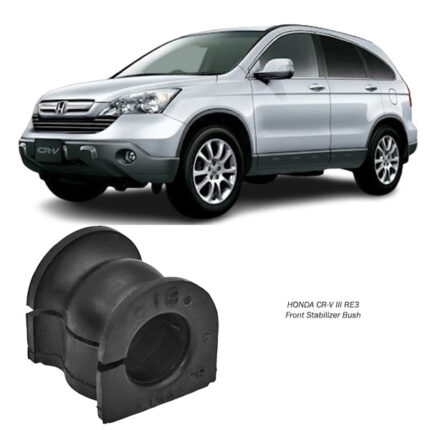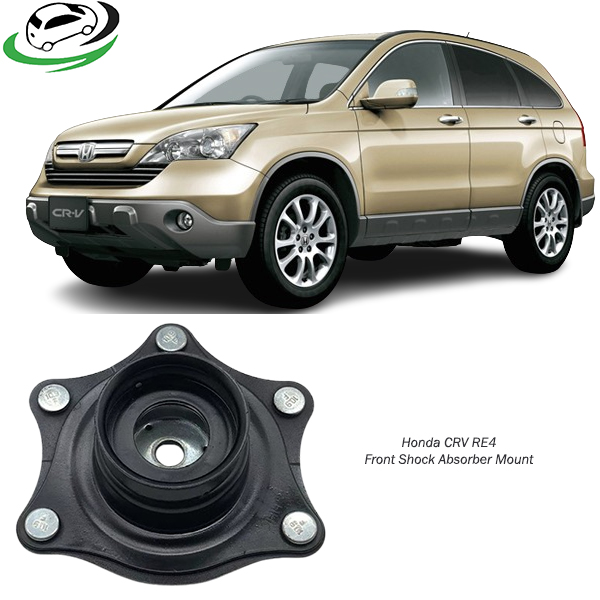-7%
Get Honda CRV RE4 Front Shock Mount 51920-SWA-A01
The front shock mount, a crucial part of a vehicle’s suspension system, serves as the primary connection point between the shock absorber and the vehicle’s chassis. Its role is to provide a stable anchor for the shock absorber while absorbing road impacts, noise, and vibrations. Here’s a comprehensive look at the front shock mount, including its structure, functionality, benefits, common issues, and maintenance tips.
1. Structure and Composition
A front shock mount is a two-part assembly made up of a metal plate, rubber or polyurethane bushings, and sometimes an integrated bearing (in strut mounts). This structure is designed to anchor the shock absorber while dampening vibrations and noise. Here are the main components:
- Metal Plate: The mount has a metal plate that bolts to the chassis of the vehicle. This plate provides structural stability, allowing the shock mount to endure heavy loads and forces during braking, turning, or driving over rough terrain.
- Rubber or Polyurethane Bushings: The rubber or polyurethane bushings absorb and dampen road vibrations and impacts. Rubber bushings provide a smoother, quieter ride but may wear out faster, while polyurethane bushings are more durable and firm but may transmit slightly more vibration.
- Bearing (in Strut Mounts): In vehicles with MacPherson struts, the front shock mount includes a bearing that allows the shock absorber to rotate with the wheels when the driver turns the steering wheel. This bearing enables smooth steering and reduces strain on other suspension parts.
2. Function of the Front Shock Mount
The front shock mount serves several key purposes, working in conjunction with the shock absorber:
- Absorbing Road Impact and Vibration: The primary function of the front shock mount is to absorb shocks from the road surface. When a vehicle drives over bumps, potholes, or uneven terrain, the shock absorber and mount work together to cushion the impact and maintain a comfortable ride for passengers.
- Reducing Noise: The rubber or polyurethane bushings in the shock mount help isolate noise generated by the suspension, ensuring that road sounds don’t transmit directly into the cabin.
- Stabilizing the Suspension System: By securely holding the shock absorber in place, the shock mount contributes to overall suspension stability. This ensures that the shock can effectively dampen up-and-down motion, preventing excess body movement.
- Supporting Steering in Strut-Based Suspensions: For vehicles with MacPherson strut suspensions, the shock mount bearing allows the strut to rotate with the steering wheel, facilitating smooth steering. This reduces wear on the shock absorber and other suspension components by allowing the wheels to turn without resistance.
3. Benefits of a Well-Maintained Front Shock Mount
A properly functioning front shock mount is essential for various aspects of vehicle performance and comfort:
- Enhanced Ride Comfort: A good-quality shock mount cushions impacts from the road, leading to a smoother, more comfortable ride. By absorbing vibrations, it prevents passengers from feeling every bump and rough spot on the road.
- Reduced Road Noise: The shock mount dampens noise from the suspension system, contributing to a quieter cabin environment. A properly functioning mount keeps noise levels down, even when driving over rough surfaces.
- Improved Steering and Handling: For vehicles with strut suspensions, the shock mount’s bearing helps facilitate smooth steering, making it easier to control the vehicle and respond to directional changes.
- Extended Suspension Component Lifespan: A stable and secure shock mount reduces the strain on other suspension parts, including the shocks, struts, and control arms. By absorbing much of the stress, the mount helps extend the life of these components.
- Better Stability and Traction: Since the shock mount plays a role in holding the suspension in alignment, it contributes to overall vehicle stability and traction, especially during cornering or driving over uneven terrain.
4. Signs of a Worn or Failing Front Shock Mount
Over time, the front shock mount can wear out due to exposure to road conditions, temperature fluctuations, and daily driving stresses. Here are some common signs of a worn or failing shock mount:
- Clunking or Knocking Sounds: A failing shock mount may produce clunking or knocking sounds, especially when driving over bumps or rough roads. This noise results from loose or worn bushings that can no longer absorb vibrations effectively.
- Excessive Vibration: If the rubber or polyurethane bushings are worn out, you might experience excessive vibrations in the steering wheel or cabin, especially at higher speeds.
- Steering Issues: For strut-based suspensions, a damaged shock mount bearing can lead to difficulty in steering or a “sticky” feeling when turning the wheel. This may be especially noticeable during parking or slow-speed maneuvers.
- Uneven Tire Wear: A faulty shock mount can lead to misalignment in the suspension, which may cause uneven tire wear. This can shorten the lifespan of your tires and compromise vehicle handling.
- Poor Ride Quality: A worn-out shock mount loses its ability to cushion impacts effectively, resulting in a rougher, more uncomfortable ride.
5. Maintenance Tips for the Front Shock Mount
Maintaining the front shock mount is crucial to ensure optimal performance and a comfortable ride. Here are some maintenance tips:
- Regular Inspection: Include the front shock mounts in regular vehicle inspections, especially if you frequently drive on rough roads or over speed bumps. Look for signs of wear, cracks, or visible damage to the bushings.
- Check for Unusual Noises: Pay attention to any clunking or knocking sounds from the front suspension. If you notice unusual noises, have the mounts and suspension components inspected promptly.
- Lubricate the Bearing (for Strut Mounts): Some strut mounts with bearings may benefit from periodic lubrication. Consult the manufacturer’s recommendations or have a professional mechanic perform this task to ensure smooth steering function.
- Replace Bushings if Needed: If the bushings in the shock mount are worn out, consider replacing them with high-quality rubber or polyurethane alternatives. Polyurethane bushings, while firmer, offer durability and can reduce the frequency of replacements.
- Inspect Alignment and Tire Wear: Keep an eye on tire wear patterns. Uneven wear can indicate suspension misalignment due to a failing shock mount. Regular tire rotations and alignments can help identify such issues early.
6. Replacement and Cost of Front Shock Mount
Replacing a front shock mount may be necessary if it is significantly worn or damaged. Here are some considerations:
- Replacement Process: Replacing a shock mount involves removing the front strut assembly, disassembling it, and installing a new mount. It requires specific tools and expertise, so professional installation is recommended.
- Cost of Replacement: The cost of replacing a front shock mount can vary based on vehicle make, model, and labor rates. Typically, a shock mount costs between $30 and $100, and labor costs can range from $100 to $200. For strut mounts with bearings, the cost may be slightly higher.
- DIY Replacement: While some car enthusiasts may attempt a DIY replacement, it’s essential to have a thorough understanding of suspension systems and the necessary tools, such as a spring compressor, to safely handle the job.
7. Choosing a Quality Front Shock Mount
When selecting a replacement front shock mount, quality is a critical factor. Here are a few things to consider:
- Material Quality: High-quality rubber or polyurethane bushings offer better durability and performance. Opt for mounts made from corrosion-resistant materials, especially if you drive in areas with high humidity or salted roads.
- Compatibility: Ensure that the shock mount is compatible with your specific vehicle make and model. Some aftermarket mounts are designed with reinforced bushings or bearings for increased durability.
- Brand Reputation: Reputable brands often offer shock mounts with warranties, providing extra assurance of quality and performance. Consider options from trusted brands to ensure longevity.
8. Conclusion
The front shock mount is a fundamental component in the suspension system, influencing ride comfort, handling, and stability. By anchoring the shock absorber and isolating vibrations, the shock mount ensures a smoother, quieter ride while protecting other suspension components from excessive wear. Recognizing signs of wear, such as unusual noises or poor ride quality, can help identify potential issues early.
Regular maintenance, timely inspections, and choosing high-quality replacement parts can prolong the life of your shock mount and keep your vehicle performing optimally. Whether you’re a daily commuter or drive on challenging roads, investing in a durable, high-performance front shock mount is key to enhancing both driving comfort and vehicle longevity.
Follow us on Facebook for more parts.



